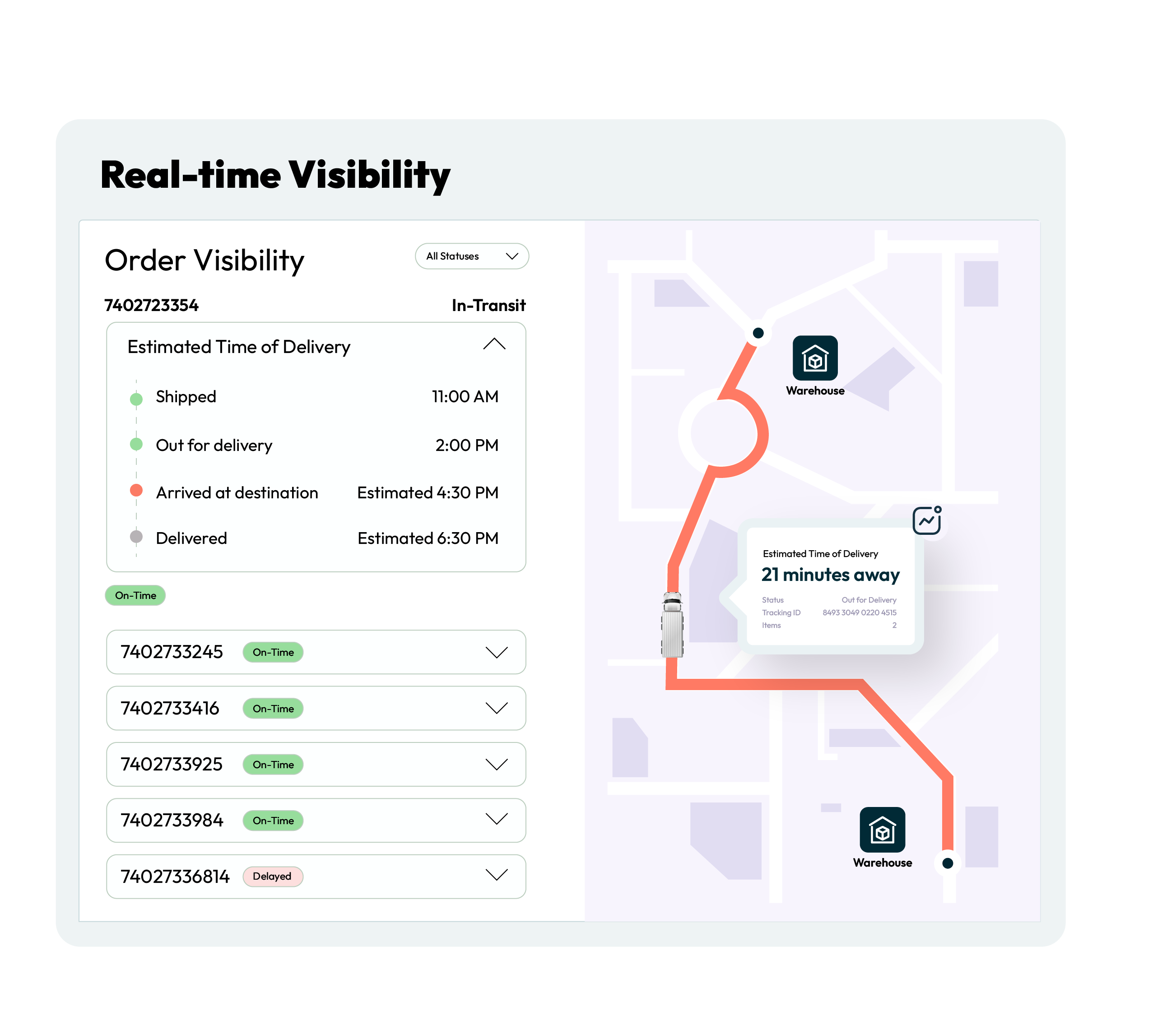- Logistics
Best Practices for Implementing Logistics Route Planning in Large Fleets
Table of Contents
- Understanding Logistics Route Planning: Beyond the Basics
- Start With Data: Laying the Foundation for Smart Routing
- Embrace Dynamic, AI-Driven Routing for True Agility
- Incorporate Multi-Constraint Planning for Scale and Efficiency
- Maximize Resource Utilization Through Automated Scheduling
- Real-Time Visibility and Predictive Service Times: Building Trust
- Align with Compliance and Sustainability Goals
- Continuously Improve with Analytics and Feedback Loops
- Bringing It All Together: The FarEye Advantage

Logistics route planning is critical for fleets that must deliver same-day or scheduled services reliably and at scale. Summer 2025 saw a notable shift in customer expectations: 64% of U.S. shoppers now expect same-day delivery for groceries and essentials. That same demand extends to larger items like air conditioners or washing machines, where consumers want not just delivery but precision installation, too. When a delivery is late or missing the mark, it isn’t just inconvenient; it damages reputation, invites complaints, and undermines repeat business.
Consider a homeowner awaiting a new AC unit during a heat wave. The order is placed, installation scheduled, and then a reroute occurs. No technician, no installation gear on board, and no ETA update. It’s a broken promise that leaves frustration in its wake.
For fleet dispatchers managing hundreds of these deliveries daily across varied vehicle types and specialized services, a single weak link in routing can ripple into major delays.
Let’s explore how robust, AI-enhanced logistics route planning transforms those monthly 100+ deliveries into a reliable, scalable operation.

Understanding Logistics Route Planning: Beyond the Basics
Logistics route planning is the art and science of designing the most efficient, reliable, and cost-effective routes for fleet vehicles while balancing business objectives, regulatory compliance, and customer promises. Today, logistics routing is no longer a traditional process. It’s dynamic, data-driven, and powered by technology that adapts in real-time to unpredictable conditions.
Unlike simple route mapping, routing in logistics must consider hundreds of factors: driver skill sets, service time windows, vehicle capacity, compliance regulations, delivery sequence, and even installation requirements. Effective logistics route planning doesn’t just get products from point A to point B; it enables business agility, reduces costs, and keeps the customer experience at the center of every mile.
Start With Data: Laying the Foundation for Smart Routing
Every efficient route begins with the right data. Large fleets generate a mountain of information on daily delivery addresses, shift rosters, order types, vehicle availability, and even weather conditions. Route planners need to ensure that every data point is accurate, up-to-date, and accessible for decision-making.
Data-driven routing in logistics leverages both historical and real-time information. By analyzing trends in previous deliveries where delays occurred, which routes performed best, and how long specific installations took, dispatchers can anticipate problems and proactively improve route efficiency.
FarEye’s AI-powered platform stands out by connecting this rich data across enterprise systems, telematics, and external sources. The result is a unified, accurate data set that fuels better, faster, and more adaptive routing decisions.
Embrace Dynamic, AI-Driven Routing for True Agility
When large fleets face unpredictable traffic, last-minute orders, and shifting service requirements, manual planning reaches its limit. This is where AI-based routing becomes a game changer. Instead of relying on fixed plans, machine learning algorithms assess real-time constraints, traffic jams, weather alerts, driver schedules, and even skill mapping for specialist installations.
Consider the scenario of an air conditioner delivery with the required installation. The system identifies a driver with the necessary installation certification, routes them efficiently to the customer, with typical client outcomes including having all needed equipment loaded on the vehicle. If the customer changes the delivery window, AI dynamically reallocates the task, reroutes the vehicle, and updates the schedule instantly.
FarEye’s proprietary AI engine enables this level of precision, allowing enterprises to automate even the most complex, multi-stop routes. Typical client outcomes show an improved ability to meet customer promises.
Incorporate Multi-Constraint Planning for Scale and Efficiency
The logistics landscape rarely presents simple problems. A single route may involve same-day deliveries, returns, pickups, temperature-controlled goods, and customer-specific service windows. Multi-constrained planning is essential, factoring in order priority, driver experience, load capacity, compliance requirements, and more.
FarEye’s platform handles more than 100 constraints, including driver certifications, DOT hours, vehicle type, and delivery sequence. Whether dispatching trucks for big and bulky goods or managing hyperlocal parcels, the software orchestrates route plans that optimize each variable. This flexibility reduces empty miles, maximizes resource utilization, and helps companies achieve on-time, in-full (OTIF) deliveries across all order types.
Maximize Resource Utilization Through Automated Scheduling
High-performing fleets aren’t just about more vehicles; they’re about smarter use of every asset. Automated scheduling is a hallmark of modern logistics routing, assigning the right vehicle and driver to each job based on skills, proximity, and availability. This reduces idle time, minimizes overtime costs, and boosts driver satisfaction.
For example, FarEye’s rate-based routing lets logistics teams seamlessly integrate gig carriers for overflow or distant deliveries, automatically comparing costs, capacity, and customer SLAs. This orchestration delivers savings without sacrificing quality or transparency, letting dispatchers adapt instantly to volume spikes or special handling requests.
Real-Time Visibility and Predictive Service Times: Building Trust
One of the most valued features of advanced route planning is real-time visibility. Dispatchers, allocators, and customer support teams gain a unified dashboard view tracking every vehicle, order, and delivery milestone live. This transparency makes it easy to answer customer queries, preempt delays, and reallocate resources as needed.
FarEye’s SMART Service Times technology takes visibility even further, predicting how long each stop will take using a combination of location data, historical service times, and AI analysis. Whether it’s a first-floor drop-off or a fifth-floor fridge installation, the system adjusts route plans to account for real-world complexities, increasing first-attempt success and improving the customer experience.
Align with Compliance and Sustainability Goals
Route planning for large fleets must align with regulatory requirements: driver work hours, vehicle weight limits, hazmat restrictions, and emissions zones. FarEye’s logistics routing solution automates compliance, with typical client outcomes including routes and driver schedules that honor local, state, and federal guidelines.
Sustainability is also woven into modern routing in logistics. By optimizing for fuel efficiency, reducing unnecessary miles, and enabling green delivery windows at checkout, companies cut costs and reduce their environmental impact. Customers are increasingly looking for eco-friendly delivery options, and smart routing helps businesses meet these evolving expectations.
Continuously Improve with Analytics and Feedback Loops
The most resilient logistics networks are those that never stop learning. Advanced logistics route planning isn’t a one-and-done project; it’s a continuous cycle of monitoring, analyzing, and refining. With FarEye, dispatchers can benchmark KPIs like on-time rate, distance traveled, service cost, and driver performance.
Regularly reviewing this data, coupled with feedback from drivers and customers, reveals bottlenecks, highlights top performers, and identifies opportunities for incremental gains. Machine learning models update with every delivery, becoming smarter and more accurate as the network evolves.
Typical rollout pilot in 2–4 weeks, system integration 2–8 weeks depending on data readiness, measurable OTIF, and cost gains within 60–90 days.
Bringing It All Together: The FarEye Advantage
Modern logistics route planning is more than a tool; it’s a strategy for operational excellence. From reducing costs and boosting productivity to elevating the customer experience, effective routing in logistics is a force multiplier for any large fleet. Enterprises leveraging FarEye’s AI-powered platform gain the agility to handle bulk orders, complex service requirements, and last-minute changes without sacrificing efficiency or compliance.
As the demands of customers and the complexities of logistics continue to grow, route planning software don’t just help you keep up; they empower your business to lead. Now is the time to move beyond manual mapping and embrace an adaptive, data-driven approach that transforms every mile into a competitive advantage.
Request a demo to see how logistics route planning can improve OTIF and lower delivery costs for your fleet.
Source:

Komal Puri is a seasoned professional in the logistics and supply chain industry. As the AVP of Marketing and a subject matter expert at FarEye, she has been instrumental in shaping the industry narrative for the past decade. Her expertise and insights have earned her numerous awards and recognition. Komal’s writings reflect her deep understanding of the industry, offering valuable insights and thought leadership.
Let's Talk to Our Experts and Optimize Your Deliveries Today!
An expert from our team will reach out within 24 hours


